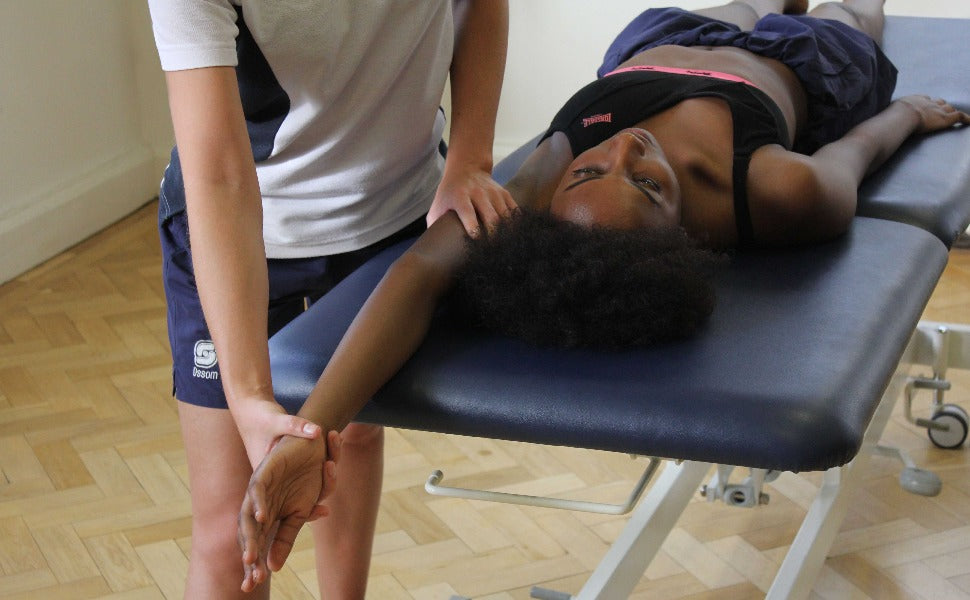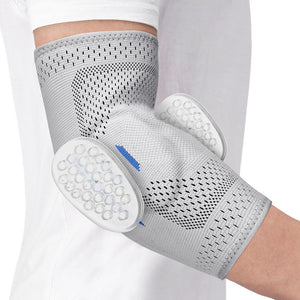What Is a Clavicle Back Brace Used for

clavicle back brace is used to stabilize the shoulder and clavicle, which improves poor posture while supporting injured areas. The adjustment should be done in a way that the brace gently pulls the shoulders back and worn for 1–2 hrs a day so as to get used to it gradually.
What Is a Clavicle Brace
A clavicle band, or , is an orthotic device used to correct and stabilize the posture of the clavicle and shoulder. Primarily, it alleviates any discomfort in the shoulder and upper back and improves poor posture. It is most suitable for cases of fractured clavicles, injured tendons of the shoulders, and dislocated acromioclavicular joints. It is mainly based on the principle of stabilizing the relative position of the scapula and clavicle, pulling the shoulders back without force to reduce the tendency of forward shoulder tilt, so as to gradually recover or enhance balance in the shoulder musculoskeletal system.
Clavicle braces are usually made from lightweight and breathable materials, such as nylon or polyester fiber, with design features of adjustable shoulder straps and a back structure to fit users with different body types. In the design of the back, combining the anatomical position of the clavicle with the shape of the scapula has made it comfortable without hindering blood circulation or limiting shoulder movement in any way. Clavicle braces come in various types, each being made up of different degrees of hardness, ranging from soft foam to rigid support straps for different degrees of injury and stages of recovery.
Why Use a Clavicle Brace
There are different uses of a clavicle brace in the context of medical professionals primarily to support and stabilize the shoulders and upper back, allowing the acromioclavicular joint to return to its normal position. The clavicle brace supports the scapula posteriorly, allowing for the thoracic spine to be neutrally positioned and helping to reduce forward tilting of the shoulders and slouching in an adjustment of upper body posture for individuals with chronic muscle fatigue and poor posture due to occupational or lifestyle habits.
-
Posture Correction: With frequent looking down or leaning forward, the shoulders tend to roll forward, allowing the chest to become constricted and the back to arch. This poor posture doesn't just affect the looks but could be a potential source of another common muscular imbalance called the Upper Crossed Syndrome, characterized by excessive tension of the pectoralis minor, trapezius, and other muscle groups while deeper muscles like subscapularis and rhomboid are being extended and lose vitality. The clavicle brace exerts a pulling force that keeps the shoulder straight and encourages a neutral thoracic spine position to reduce the early symptoms of Upper Crossed Syndrome.
-
Relieving Shoulder and Clavicle Pain: Prolonged pain may appear in some of the . The clavicle brace offers extra supports to reduce the burden on the acromioclavicular joint thus minimizing pain through movement. Soft tissue injuries from sports trauma or shoulder trauma require bracing, taking a course that stabilizes the affected area and protects it against excessive movements or secondary injury.
-
Assisting in Fracture Healing: Clavicle fractures are easily caused, especially by traumas in traffic and sports. Conservative therapy is generally used in the treatment of clavicle fracture and avoids surgical intervention as much as possible. A clavicle brace is an essential auxiliary tool in conservative therapy for clavicle fractures. By stabilizing the relative position of the scapula and clavicle, the brace prevents the fractured bone from displacing or healing improperly, thus promoting better fracture healing quality.
-
Preventing Shoulder Muscle Imbalance: Poor posture or the recovery phase following an injury may result in shoulder muscles becoming imbalanced as a result of uneven loading-the muscle groups that become tense and contracted might include the upper trapezius and the pectoralis minor. This, over time, may lead to compensatory shoulder muscle disorders such as shoulder impingement syndrome. The use of the clavicle brace provides support to the shoulders and, therefore, allows the muscles to distribute the pressure more evenly without the detrimental impact of muscle imbalance.

Posture Benefits
Good posture is essential to the health of the spine, muscular balance, and aesthetic appeal of the body. The clavicle brace stabilizes the position of the shoulder and musculoskeletal system of the upper back, helping to correct poor postures such as forward shoulder tilt and slouching. During posture adjustment, the pulling force from the brace encourages the scapula to move back, opening up the thoracic spine and allowing the spine to be in a more natural, neutral position-important for long-term posture maintenance.
puts more burdens on the cervical spine; the muscles of the neck will be in tension for a long time, and cervical lordosis or pain in necks and shoulders may subsequently occur. In this respect, the clavicle brace can relieve the discomfort brought about by bad posture to a certain degree, as it straightens the shoulders. Good posture promotes lung function. Under good postures of the body, the chest can be fully opened, thus smoothing the process of respiration and raising the efficiency of ventilation of lungs.
A clavicle brace would be advantageous for thoracic and lumbar health, mainly regarding posture correction at the thoracolumbar part. Also, users who wear it over time naturally develop muscle memory to keep the shoulders open and chest expanded when they are not using it, which reduces fatigue and soreness related to poor posture.
Injury Recovery
Clavicle braces are standard in the treatment of both sports medicine and trauma recovery. In shoulder injuries, such as clavicle fractures, acromioclavicular joint dislocation, and scapula strains, the brace supports the structure of the shoulder to decrease the activity of the injured area during recuperation and protects and supports it while healing. In the instance of clavicle fractures, the bone will have to return to its natural position to heal properly, and thus the correct angle of the clavicle and scapula is maintained by the brace to prevent the bones from displacing and improper healing of the bones.
-
Reducing the Load on Acromioclavicular Joint Injuries: The acromioclavicular joint-connecting scapula and clavicle-is easily injured in sports that involve high impact, such as basketball and skiing. Stabilization of this joint by the clavicle brace reduces the load on the joint and helps restore its normal function.
-
Stabilizing Shoulder Soft Tissue Injuries: Soft tissue strains or tears in the shoulder usually occur from sports or accidents, involving rotator cuff muscles such as the supraspinatus, infraspinatus, and subscapularis. A clavicle brace restricts mobility in the shoulder and indirectly decreases tension on the rotator cuff, giving the injured soft tissues of the shoulder a chance to recover.
-
Postoperative Rehabilitation Aid: Stability of the clavicle brace after is important in order to avoid secondary injury and reduce pain. During the healing phase of the operation area, it is very fragile, and support from the brace saves accidental pulls or sudden movements of the shoulder that may affect this area and give it necessary time and conditions to heal.
-
Restoring Scapular Function: The scapula is the central support for movements of the upper limb that help individuals execute general life activities like pushing, pulling, and lifting. During recovery, the brace secures the scapula in order to avoid any displacement or abnormal movement; this helps the scapula function return to normal and regain the strength of the upper limbs gradually.
How to Wear It Right
The application of a clavicle brace correctly depends largely on the ability to find the for such a brace in order to achieve maximum stability. First, the shoulder strap of the brace should fit into the natural curve of the shoulder without pressing against shoulder muscles or soft tissues located above the clavicle. The back portion of the brace should stay at the center of the upper back, helping to maintain the scapula's natural position.
Once worn to provide support-not too tightly, as this can impede blood circulation-the length of the shoulder straps should be fixed by personal shoulder width and body type. Generally, light movements such as raising the arms or stretching back and forth should be done once the brace is worn to ensure it does not constrict movement in a large way. Also, ensure the brace is not too constricting under the arms and sides of the shoulders, to prevent skin irritation or discomfort and muscle soreness.
Adjustment Tips
Proper adjustment of the clavicle brace during daily use is important and needs to be considered, taking into account different body types and purposes. In general, a basic adjustment should create moderate tightness: neither too tight, to avoid redness of the skin or discomfort of the muscles, nor too loose, since in that case it would reduce the given support.
-
Check Strap Tightness: During use, you can feel whether or not the strap is tight by touch. If it feels a bit loose, then you should loosen or tighten the strap a little. Adjusting a strap should stabilize the shoulders without impeding blood circulation.
-
Symmetrical Adjustment: Symmetrical tenseness of the shoulder straps adjusts to avoid asymmetric posture or asymmetric load on the shoulder muscles. Asymmetric wear over a long period could be a cause of imbalance in the shoulder muscle load.
-
Regularly Check Brace Position: As minor adjustments of this brace may occur during a typical day, one should check every 1–2 hours to ensure it remains in proper position. Adjustments should be made accordingly. Light pulling of the back strap secures its position so as to fit better in the shoulder and back structures.
Getting the Most Out of It
Wearing the clavicle brace in tandem with posture correction and muscle strengthening maximizes its effectiveness. Instead of depending solely on stability given by the support of the brace, scientific exercises will strengthen the shoulder, upper back, and core muscles to help with sustaining posture stability.
-
Combine with Posture Training: Wear the while standing or sitting in front of a mirror to observe if your shoulders are open and your chest is lifted as a means of visually reinforcing posture correction.
-
Strengthen Shoulder Muscles: Perform some light shoulder muscle-strengthening exercises while in the brace, such as scapular retractions and rhomboid contractions. Strengthening shoulder muscles can decrease reliance on the brace, as natural muscle support becomes stronger.
-
Maintain Good Posture in Daily Activities: Keep good posture at work and home, and avoid continuous looking down or slouching. The brace is an auxiliary tool, while good posture is the key for long-term health.
Scientific use of the clavicle brace can effectively improve upper back posture, recover the shoulder, alleviate pain, and prevent secondary injury. In the meantime, it is not a panacea; that is to say, it should be used in concert with other posture corrections, rehabilitation trainings, and a healthy lifestyle
-
Posted in
Brace














